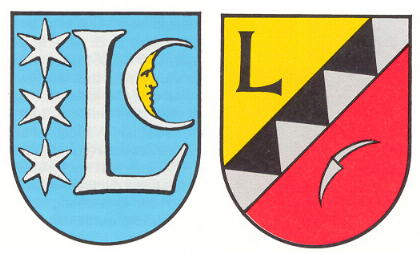Lingenfeld: Difference between revisions
Knorrepoes (talk | contribs) No edit summary |
Knorrepoes (talk | contribs) m (Text replace - "[[Literature" to "{{media}} [[Literature") |
||
| Line 21: | Line 21: | ||
The letter L is the town's initial. The bend is derived from the arms of the Lords of Lengenfeld, who historically ruled the village. Together with a crescent these elements were derived from 18<sup>th</sup> century seals. Later, an older seal was discovered, showing a plough iron. This was most likely a (common) agricultural symbol. It has added in 1968 is a rather unusual shape, resembling the replaced crescent. | The letter L is the town's initial. The bend is derived from the arms of the Lords of Lengenfeld, who historically ruled the village. Together with a crescent these elements were derived from 18<sup>th</sup> century seals. Later, an older seal was discovered, showing a plough iron. This was most likely a (common) agricultural symbol. It has added in 1968 is a rather unusual shape, resembling the replaced crescent. | ||
{{media}} | |||
[[Literature]] : Stadler, K. : Deutsche Wappen - Bundesrepublik Deutschland. Angelsachsen Verlag, 1964-1971, 8 volumes. | [[Literature]] : Stadler, K. : Deutsche Wappen - Bundesrepublik Deutschland. Angelsachsen Verlag, 1964-1971, 8 volumes. | ||
Revision as of 00:52, 9 July 2014
| Heraldry of the World Civic heraldry of Germany - Deutsche Wappen (Gemeindewappen/Kreiswappen) |
LINGENFELD
State : Rheinland-Pfalz
District (Kreis) : Germersheim
Verbandsgemeinde : Verbandsgemeinde Lingenfeld
Official blazon
Origin/meaning
The arms were granted in 1841 by King Ludwig I of Bayern, and were based on elements from the two historical seals of the town. In 1968 the arms were slightly changed, the crescent in the lower half was replaced by a plough iron.
The letter L is the town's initial. The bend is derived from the arms of the Lords of Lengenfeld, who historically ruled the village. Together with a crescent these elements were derived from 18th century seals. Later, an older seal was discovered, showing a plough iron. This was most likely a (common) agricultural symbol. It has added in 1968 is a rather unusual shape, resembling the replaced crescent.
Contact and Support
Partners:
Your logo here ?
Contact us
© since 1995, Heraldry of the World, Ralf Hartemink 
Index of the site
Literature : Stadler, K. : Deutsche Wappen - Bundesrepublik Deutschland. Angelsachsen Verlag, 1964-1971, 8 volumes.











